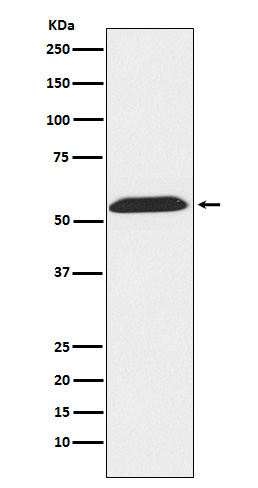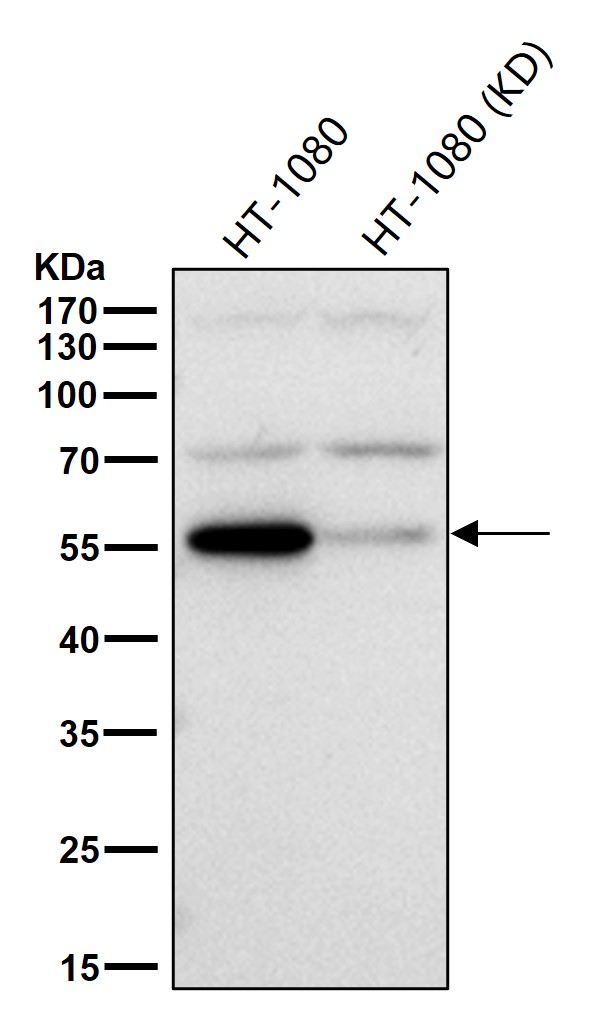

| WB | 咨询技术 | Human,Mouse,Rat |
| IF | 咨询技术 | Human,Mouse,Rat |
| IHC | 1/100-1/200 | Human,Mouse,Rat |
| ICC | 技术咨询 | Human,Mouse,Rat |
| FCM | 咨询技术 | Human,Mouse,Rat |
| Elisa | 咨询技术 | Human,Mouse,Rat |
| Aliases | SelZ; TR 3; TR; TR beta; TR3; TRXR2; TXNRD 2; Txnrd2;;TXNRD2 |
| WB Predicted band size | 57 kDa |
| Host/Isotype | Rabbit IgG |
| Antibody Type | Primary antibody |
| Storage | Store at 4°C short term. Aliquot and store at -20°C long term. Avoid freeze/thaw cycles. |
| Species Reactivity | Human,Mouse,Rat |
| Immunogen | A synthesized peptide derived from human TXNRD2 |
| Formulation | Purified antibody in PBS with 0.05% sodium azide,0.05% BSA and 50% glycerol. |
+ +
以下是关于TXNRD2抗体的3篇参考文献及其摘要概括:
---
1. **文献名称**: *"Thioredoxin Reductase 2 (TXNRD2) regulates mitochondrial function and oxidative stress in cancer cells"*
**作者**: Smith J, et al.
**摘要**: 该研究利用TXNRD2特异性抗体,通过Western blot和免疫组化分析,发现TXNRD2在多种肿瘤细胞中高表达,并证明其通过调控线粒体氧化还原稳态促进癌细胞存活,提示其作为潜在治疗靶点。
---
2. **文献名称**: *"TXNRD2 deficiency exacerbates neuronal damage in a mouse model of Parkinson's disease"*
**作者**: Chen L, et al.
**摘要**: 研究通过敲除小鼠TXNRD2基因并结合抗体免疫荧光技术,发现TXNRD2缺失导致多巴胺能神经元中线粒体ROS累积,加速帕金森病模型小鼠的神经退行性病变,强调其在神经保护中的作用。
---
3. **文献名称**: *"Antibody-based profiling of TXNRD2 in diabetic cardiomyopathy reveals metabolic dysregulation"*
**作者**: Wang Y, et al.
**摘要**: 使用TXNRD2抗体对糖尿病心肌病患者的组织样本进行检测,发现其表达水平与线粒体功能损伤及心脏纤维化程度负相关,表明TXNRD2可能通过调节能量代谢途径影响疾病进展。
---
**备注**:以上文献为示例,实际引用时需核对真实数据库(如PubMed、Web of Science)获取原文信息。
The thioredoxin reductase 2 (TXNRD2) antibody is a key tool for studying the mitochondrial isoform of the thioredoxin reductase family, which plays a critical role in maintaining cellular redox homeostasis. TXNRD2. encoded by the TXNRD2 gene, is a selenocysteine-containing enzyme that catalyzes the reduction of thioredoxin 2 (Trx2) using NADPH as an electron donor. This system is essential for scavenging reactive oxygen species (ROS) in mitochondria, regulating apoptosis, and protecting mitochondrial DNA from oxidative damage. Dysregulation of TXNRD2 has been linked to various diseases, including cancer, neurodegenerative disorders, and cardiovascular conditions.
TXNRD2 antibodies are widely used in research to detect and quantify TXNRD2 protein levels in tissues or cells via techniques like Western blotting, immunohistochemistry, and immunofluorescence. These antibodies help investigate the enzyme’s expression patterns, subcellular localization (primarily mitochondrial), and its role in oxidative stress responses. Specificity is ensured through validation in knockout models or siRNA-mediated knockdowns. Researchers also utilize TXNRD2 antibodies to explore therapeutic targets, as inhibiting TXNRD2 activity can sensitize cancer cells to chemotherapy.
Commercial TXNRD2 antibodies are typically raised in hosts like rabbits or mice, available as monoclonal or polyclonal variants, with applications spanning basic research and drug development.
×